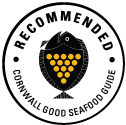

There are many species of seaweed that can be found in Cornish waters that are edible. Seaweed is being increasingly used in cooking in the UK and there are several businesses in Cornwall that are selling Cornish seaweed.
Currently the scale of seaweed collection around our coasts is small but if demand increases we may reach a point where collection impacts our marine environment. Only source seaweed from licenced collectors who are operating in a sustainable way and can demonstrate that they follow the Natural England code of conduct for seaweed collection. The rating for seaweed was created by Cornwall Wildlife Trust as at present the scoring methodology created by MCS does not apply to this kind of seafood production.

Cornish coastal water

Seaweed is hand collected on a small scale with minimal impact at current low levels. current methodology does not allow seaweed to be rated using MCS ratings system, however it is recommended by Cornwall Good Seafood Guide.
Learn more
Cornwall

Seaweed is being farmed in Cornwall on a small scale but there are plans to upscale in the future. The current MCS methodology does not allow seaweed to be rated, however it is recommended by Cornwall Good Seafood Guide
Learn moreCornwall Good Seafood Guide rates seafood sustainability using a scale of 1to 5
1,2 and 3 are recommended, Fish to avoid are rated 5.
The ratings for this species are produced independently by Cornwall Wildlife Trust as a guide to help consumers make good seafood choices. click here.
There are over 350 species of red seaweeds found in the UK and in Cornwall we have many of these. Red seaweeds that can be eaten include carrageen (Chondrus crispus), laver or nori (Porphyra spp) pepper dulse (Osmundia pinnatifida), and dulse (Palmaria palmata).
There are around 150 species of brown seaweed found in UK waters and many edible ones are common in Cornish waters including, channeled wrack (Pelvitia caniculata), sea bean (Himenthalia elongata) and dabberlocks (Alaria esculenta). Kelps such as sugar kelp (Saccharina lattissima) and the invasive species Wakame (Undaria pinnitifida), and wire weed (Sargassum muticum) and harpoon weed (Asparagopsis armata) can also be found in Cornish waters. Sea weeds have complex lifecycles and some for example egg wrack (Ascophyllum nodosum) are very slow growing and vulnerable to over harvesting. There is a natural high turnover of seaweed and many coasts see huge amounts of seaweed washed up after storms. These so called drift seaweeds are the best to harvest as their removal from the habitat is a natural process.
It is well known that there are many common seaweeds in Cornish coastal waters and that there are large stocks of many commercial species but no detailed stock assessment has been carried out to date. It is estimated that at current times approx. 5 or 6 tonnes of wet seaweed is commercially harvested by hand in Cornwall. Accurate figures are not available. Seaweeds are generally fast growing and every winter many species will naturally die back. If appropriately managed there is definately scope for a sustainable seaweed industry in Cornish waters.
Under the public right to fish in tidal waters, floating seaweed can be collected at high water. However, when the tide is out, this right does not extend to collection of seaweed from the shore. In order to collect seaweed from the shore, the landowner’s permission is always required, this includes the collection of drift seaweed as well as attached seaweed. All harvesters of seaweed on a commercial basis have to have permission from Natural England and they also have to have permission of the owner of the shore from which they are collecting seaweed. The owners may put management restrictions on the collector. Crown estate owns the intertidal below mean low water in most areas and it also owns much of the foreshore although there are many other organisations and private landowners who own the rights to parts of the intertidal around the Cornish coast. Crown estate always consults Natural England when granting a licence to a commercial operator to harvest seaweed. Natural England have created a seaweed harvesting code of conduct which all seaweed collectors are advises to adhere to. Collecting seaweed within Sites of Special Scientific Interest (SSSIs) is prohibited without the permission of the landowner and Natural England. Within Marine Conservation Zones IFCAs have the right to manage seaweed harvesting. It is Crown Estates policy not to allow seaweed collection in any marine protected areas.
Hand gathered on the shore. Drift seaweeds are the best to collect but some operators are licenced to pick seaweeds in controlled amounts.






Cornwall Good Seafood Guide is underpinned by the Marine Conservation Society (MCS) Good Fish Guide. The first UK consumer guide to sustainable seafood. For more information visit www.fishonline.org
Cornwall Good Seafood Guide is here to help us all make sustainable seafood choices. Choices that will help us keep the oceans healthy and Cornish fishers' futures safe. This website is funded by Cornwall Wildlife Trust. If you would like to make a meaningful difference to the health of our oceans, please consider making a donation to the Cornwall Wildlife Trust Ocean Emergency fund. Your donation will help safeguard these remarkable environments, ensuring that they continue to thrive for generations to come. Together, we can be stewards of the seas and champions for a healthier, more sustainable future.